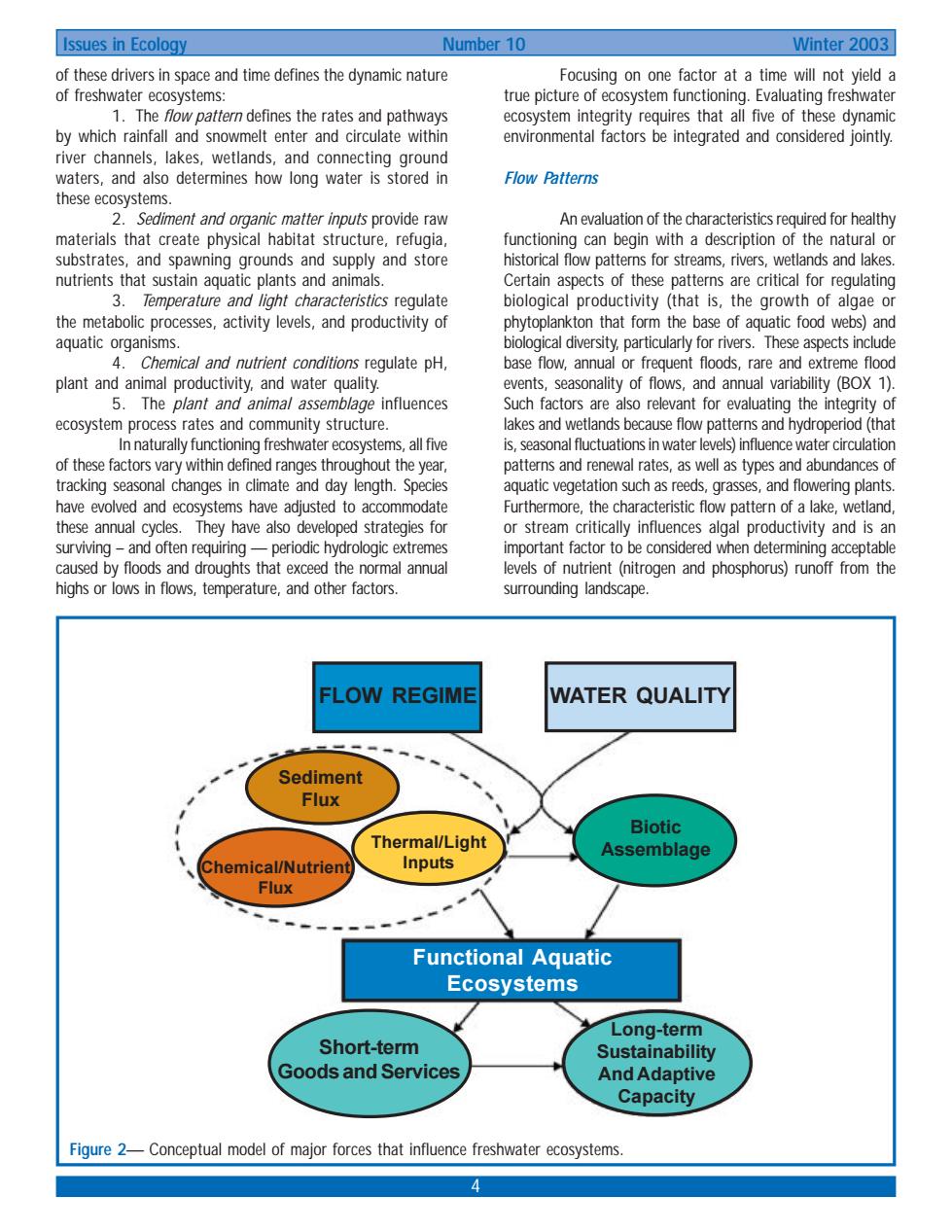正在加载图片...

Issues in Ecology Number 10 Winter 2003 of these drivers in space and time defines the dynamic nature Focusina on one factor at a time will not vield a of freshwater ecosy stems true picture of ecosystem functioning.Evaluating freshwater 1.The flow pattern defines the rates and pathways ecosystem integrity requires that all five of these dynamic by which rainfall and snowmelt enter and circulate within environmental factors be integrated and considered jointly. river channels,lakes,wetlands,and connecting ground waters,and also determines how long water is stored in Flow Patterns these ecosystems. 2 Sediment and organic matter inouts provide raw An evaluation of the characteristics required for healthy materials that create physical habitat structure,refugia, functionina can beain with a description of the natural or substrates,and spawning grounds and supply and store historical flow pattermns for streams,rivers,wetlands and lakes nutrients that sustain aquatic plants and animals. Certain aspects of these patterns are critical for regulating Temperature and light characteristics requlate biological productivity (that is,the growth of algae or the metabolic processes.activity levels,and productivity of phytoplankton that form the base of aquatic food webs)and aquatic organisms. biological diversity.particularly for rivers.These aspects include Chemical and nutrient conditions regulate pH. base flow,annual or frequent floods,rare and extreme flood plant and animal productivity,and water quality. events. seasonality of flows,and annual variability (BOX 1) The plant and anima assemblage influences Sucn ractors are also relevant for evaluating the integrity o ecosystem proces community structure and because flow patterns and hydrope (tha ations in water le these factors vary within deine the yea ates,as well as types a aqu such as nd and 2in atter or ences uctivity and is ann ogen highsr lows in flows.te erature.and other surroundin LOW REGIME WATER QUALITY Sediment Biotic The rmal/Light Assemblage Chemical/Nutrier Inputs Flux Functional Aquatic Ecosystems Short-term ng-term Sustainability Goods and Services And Adaptive Capacity Figure 2-Conceptual model of major forces that influence freshwater ecosystems.4 Issues in Ecology Number 10 Winter 2003 of these drivers in space and time defines the dynamic nature of freshwater ecosystems: 1. The flow pattern defines the rates and pathways by which rainfall and snowmelt enter and circulate within river channels, lakes, wetlands, and connecting ground waters, and also determines how long water is stored in these ecosystems. 2. Sediment and organic matter inputs provide raw materials that create physical habitat structure, refugia, substrates, and spawning grounds and supply and store nutrients that sustain aquatic plants and animals. 3. Temperature and light characteristics regulate the metabolic processes, activity levels, and productivity of aquatic organisms. 4. Chemical and nutrient conditions regulate pH, plant and animal productivity, and water quality. 5. The plant and animal assemblage influences ecosystem process rates and community structure. In naturally functioning freshwater ecosystems, all five of these factors vary within defined ranges throughout the year, tracking seasonal changes in climate and day length. Species have evolved and ecosystems have adjusted to accommodate these annual cycles. They have also developed strategies for surviving – and often requiring — periodic hydrologic extremes caused by floods and droughts that exceed the normal annual highs or lows in flows, temperature, and other factors. Focusing on one factor at a time will not yield a true picture of ecosystem functioning. Evaluating freshwater ecosystem integrity requires that all five of these dynamic environmental factors be integrated and considered jointly. Flow Patterns An evaluation of the characteristics required for healthy functioning can begin with a description of the natural or historical flow patterns for streams, rivers, wetlands and lakes. Certain aspects of these patterns are critical for regulating biological productivity (that is, the growth of algae or phytoplankton that form the base of aquatic food webs) and biological diversity, particularly for rivers. These aspects include base flow, annual or frequent floods, rare and extreme flood events, seasonality of flows, and annual variability (BOX 1). Such factors are also relevant for evaluating the integrity of lakes and wetlands because flow patterns and hydroperiod (that is, seasonal fluctuations in water levels) influence water circulation patterns and renewal rates, as well as types and abundances of aquatic vegetation such as reeds, grasses, and flowering plants. Furthermore, the characteristic flow pattern of a lake, wetland, or stream critically influences algal productivity and is an important factor to be considered when determining acceptable levels of nutrient (nitrogen and phosphorus) runoff from the surrounding landscape. Figure 2— Conceptual model of major forces that influence freshwater ecosystems. FLOW REGIME WATER QUALITY Sediment Flux Chemical/Nutrient Flux Thermal/Light Inputs Biotic Assemblage Functional Aquatic Ecosystems Short-term Goods and Services Long-term Sustainability And Adaptive Capacity